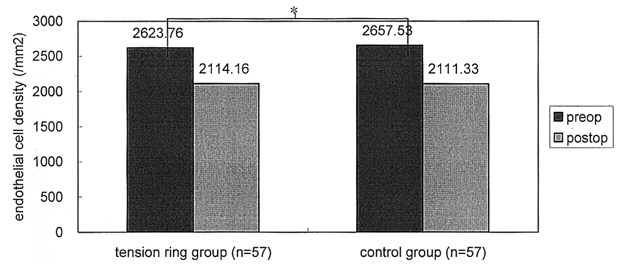Korean J Ophthalmol.
2005 Mar;19(1):23-28. 10.3341/kjo.2005.19.1.23.
The Effect of Capsular Tension Ring on Posterior Capsular Opacity in Cataract Surgery
- Affiliations
-
- 1Department of Ophthalmology, Kangnam St. Mary's Hospital, College of Medicine, The Catholic University of Korea, Seoul, Korea. ckjoo@catholic.ac.kr
- 2Laboratory of Ophthalmology and Visual Science, College of Medicine, The Catholic University of Korea, Seoul, Korea.
- KMID: 1099081
- DOI: http://doi.org/10.3341/kjo.2005.19.1.23
Abstract
- This study was performed to evaluate the efficacy and safety of the capsular tension ring on posterior capsular opacity in comparison with cases undergoing intraocular lens (IOL) implantation alone. We analyzed 127 eyes which had undergone cataract surgery, including capsular tension ring insertion, along with 127 eyes which had undergone IOL implantation alone by the same surgeon from September 1998 to March 2003. In the insertion group, 41 eyes (group A) had been followed up for more than one year after silicone IOL implantation, as had 40 eyes (group B) in the control group. We compared the incidence, type, and degree of capsular opacity between A and B groups and also endothelial cell loss after surgery between the two groups. For insertion group A, the frequency of posterior capsular opacity was lower (7.3%), the duration to development was longer, and the energy required for Nd-Yag capsulotomy of PCO was less than for control group B (25%) (p=0.037). The endothelial cell count loss rate was not significantly different between the two groups (p=0.522). The capsular tension ring is associated with a significantly reduced incidence of posterior capsular opacity and is a safe procedure.
MeSH Terms
-
Adult
Aged
Aged, 80 and over
Capsulorhexis/*instrumentation
Cataract/*prevention & control
Female
Humans
Lens Capsule, Crystalline/*pathology
Lens Implantation, Intraocular
Male
Middle Aged
Phacoemulsification
Polymethyl Methacrylate
Postoperative Complications/*prevention & control
*Prostheses and Implants
*Prosthesis Implantation
Safety
Treatment Outcome
Figure
Reference
-
1. Hara T, Hara T, Yamada Y. "Equator Ring" for maintenance of the completely circular contour of the capsular bag equator after cataract removal. Ophthalmic Surg. 1991. 22:358–359.2. Lim HS, Cha SC, Lee SH. Phacoemulsification and Intraocular Lens Implantation using the Capsular Tension Ring. J Korean Ophthalmol Soc. 1999. 40:3037–3044.3. Joo CK, Park YJ, Lee HY, Lee DH. The Effect of Capsular Tension Ring on Anterior Capsular Opening and Intraocular Lens in Cataract Surgery. J Korean Ophthalmol Soc. 2000. 41:627–636.4. Park YK, Choi NY, Lee DH, Joo CK. The Effect of Capsular Tension Ring on Posterior Capsular Opacity in Cataract Surgery. J Korean Ophthalmol Soc. 2002. 43:819–821.5. Apple DJ, Solomon KD, Tetz MR. Posterior capsule opacification. Surv Ophthalmol. 1992. 137:73–116.6. Schaumberg DA, Dana MR, Christen WG, Glynn RJ. A systemic overview of the incidence of posterior capsular opacification. Ophthalmology. 1998. 105:1213–1221.7. Steinert Roger F.. Cataract surgery: Technique, complications, management. 2004. 2nd ed. Philadelphia: Saunders;462.8. Nishi O, Nishi K, Menapace R. Capsule-bending ring for the prevention of capsular opacification: a preliminary report. Ophthalmic Surg Lasers. 1998. 29:749–753.9. Nishi O, Nishi K, Mano C, et al. The inhibition of lens epithelial cell migration by a discontinuous capsular bend created by a band-shaped circular loop or a capsule-bending ring. Ophthalmic Surg Lasers. 1998. 29:119–125.10. Apple DJ, Peng Q, Visessook N, et al. Surgical prevention of posterior capsule opacification. Part 1: Progress in eliminating this complication of cataract surgery. J Cataract Refract Surg. 2000. 26:180–187.11. Peng Q, Apple DJ, Visessook N, et al. Surgical prevention of posterior capsule opacification. Part 2: Enhancement of cortical cleanup by focusing on hydrodissection. J Cataract Refract Surg. 2000. 26:188–197.12. Peng Q, Visessook N, Apple DJ, et al. Surgical prevention of posterior capsule opacification. Part 3: Intraocular lens optic barrier effect as a second line of defense. J Cataract Refract Surg. 2000. 26:198–213.13. Apple DJ. Influence of intraocular lens material and design on postoperative intracapsular cellular reactivity. Trans Am Ophthalmol Soc. 2000. 98:257–283.14. Nishi O, Nishi K. Preventing posterior capsule opacification by creating a discontinuous sharp bend in the capsule. J Cataract Refract Surg. 1999. 25:521–526.15. Nishi O, Nishi K, Sakanishi K. Inhibition of migrating lens epithelial cells at the capsular bend created by the rectangular optic edge of a posterior chamber intraocular lens. Ophthalmic Surg Lasers. 1998. 29:587–594.16. Hollick EJ, Spalton DJ, Ursell PG, et al. The effect of polymethylmethacrylate, silicone, and polyacrylic intraocular lenses on posterior capsular opacification 3 years after cataract surgery. Ophthalmology. 1999. 106:49–55.
- Full Text Links
- Actions
-
Cited
- CITED
-
- Close
- Share
- Similar articles
-
- The Effect of Capsular Tension Ring on Posterior Capsular Opacity in Cataract Surgery
- Phacoemulsification and Intraocular Lens Implantation using the Capsular Tension Ring
- The Effect of Capsular Tension Ring on Anterior Capsular Opening and Intraocular Lens in Cataract Surgery
- The Effect of the Remnants after Cataract Extraction on the Lens Epithelial Cell Culture
- Analysis of after Cataract using Scheimpflug Camera



